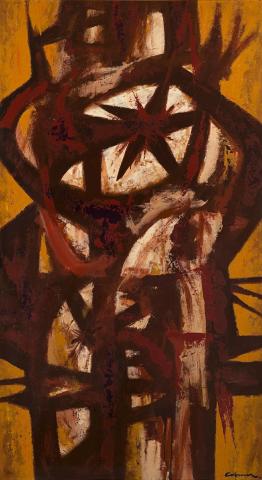THE TOWER, 1963
JOHN COBURN
synthetic polymer paint on composition board
168.0 x 91.0 cm
signed lower right: Coburn
dated and inscribed verso: JOHN COBURN / 1 MACEDON PL WARRIEWOOD NSW. "THE TOWER" 2/63
Institutional collection, Sydney
John Coburn, Hungry Horse Gallery, Sydney, 11 June - 5 July 1963
Sydney Royal Easter Show Art Exhibition, c1964 (partial label attached verso)
1967 International and Universal Exposition (Expo - 67), Montreal, Canada, 28 April - 27 October 1967, cat. 10 (label attached verso)
James Gleeson Oral History Collection, Interview with John Coburn, 30 May 1979, National Gallery of Australia Research Library, Canberra,
Amadio, N., John Coburn: Paintings, Craftsman House, Sydney, 1988, p. 196
In 1963 John Coburn held a solo exhibition at the Hungry Horse Gallery in Sydney, where The Tower was one of thirty paintings and drawings exhibited. Representing a significant phase of Coburn's career, The Tower was one of the first works that he executed in synthetic polymer paint after years of working almost exclusively with oils. The flexible nature of synthetic polymer paint allowed Coburn a certain freedom and spontaneity which translates onto the surface through the liberally applied layers of paint. This is particularly noticeable when compared to the highly constructed works that Coburn would go on to produce. The picture on offer was considered by the artist to 'satisfactorily' represent his period of the early 1960s, where he had recently adopted a freer expressionistic style.1 In an interview with James Gleeson in 1979, Coburn discusses The Tower and its relevance to his oeuvre:
'The Tower is a work done, I think, in 1963. It represents a break from the sort of work I was doing just a few years before that. I moved from Rose Bay to Warriewood and for the first time in my life I had a studio in which to work. I took great delight in splashing a lot of paint around and also abstract expressionism, of course, was still very much in the air at that time.'2
Coburn's enthusiasm is clearly visible and highly emotive, as the darker palette and intensity of the composition resonates with the viewer. The fervent brushstrokes create a powerful allusion to ornate stained glass windows of cathedrals and to various religious motifs such as the crown of thorns, the crucifixion and the Tower of Babel. The Tower of Babel is a biblical narrative from the Book of Genesis and tells the tale of a single population of people who spoke one language and settled in the land of Shinar. They endeavoured to build a grand city and a mighty tower which would reach heaven, which would thus seemingly render God useless. God came down to earth and in order to humble humanity, he scattered the people and transformed their speech into many languages so that they would be divided and unable to communicate.
After rejecting religion during his teenage years, Coburn converted to Catholicism during the early 1950s. His interest in religious subjects began following discussions with Father Scott, an organiser of the prestigious Blake Prize for Religious Art. Coburn submitted various artworks throughout the fifties, but it was not until 1960 that he was awarded the Prize for his painting The Passion, 1960. Despite his many depictions of landscapes and the seasons, Coburn is still labelled as a religious artist, as Nadine Amadio discusses 'He could certainly be termed a religious painter as all his art, even when it is not specifically sacred, is religious in terms of being a celebration of creation, of the development of the human spirit, and of the orders of nature.'3
1. Interview between John Coburn and James Gleeson, 30 May 1979, National Gallery of Australia website, <http://www.nga.gov.au/research/gleeson/pdf/coburn.pdf> viewed 17 March 2014
2. ibid.
3. Amadio, D., John Coburn: Paintings, Craftsman House, Sydney, 1988, p. 7
CASSI YOUNG
